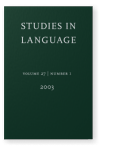Vol. 27:1 (2003) ► pp.113–170
Clause combining in Chechen
Chechen exhibits three major strategies for the combination of clauses: coordination, chaining, and subordination. The major formal characteristics of these three traditional categories of clause linking are discussed with reference to their basic syntax and semantics as well as to more particular syntactic characteristics, including constituent order and behaviour with respect to negation and wh-questions. In addition, these clause combining strategies of Chechen are classified with respect to Foley and Van Valin’s (1984) typology of clause linkage. A particularly useful result of this classification is that it permits a straightforward characterization of the use of the preverbal conjunctive enclitic ’a as a marker of cosubordination.
Cited by (9)
Cited by 9 other publications
This list is based on CrossRef data as of 18 july 2024. Please note that it may not be complete. Sources presented here have been supplied by the respective publishers. Any errors therein should be reported to them.
